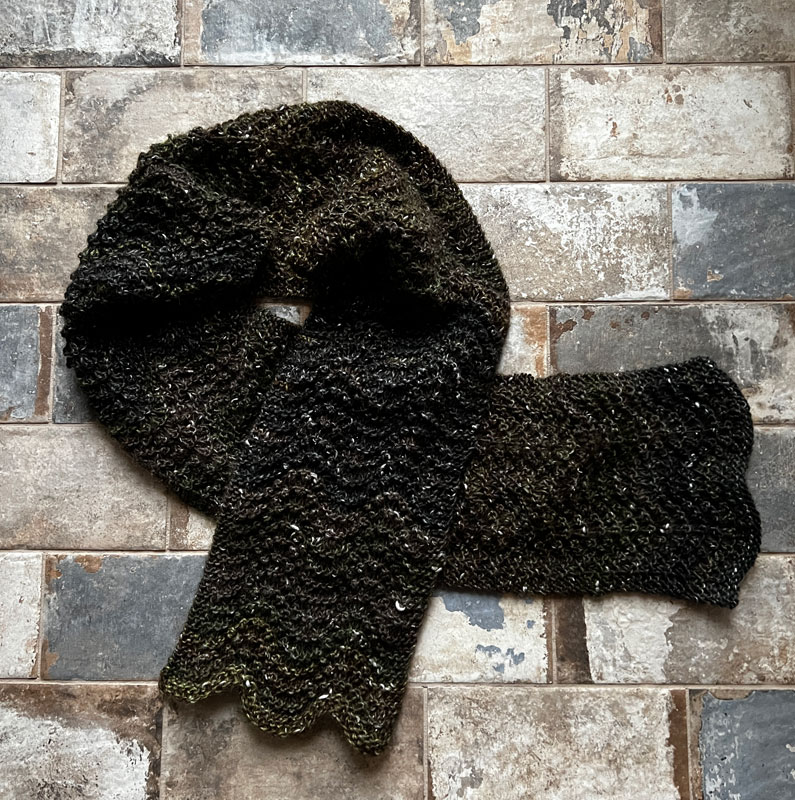
Feather and fan patterns. They all look a bit like feathers fanned out. I guess?
This one is Linda Smith’s version, her Feather & Fan Dishcloth. I’ve knit it. Ahem. An embarrassing lot of times. Let’s just leave it at that. This time I knit it in Queensland Collection’s Coastal Cotton. It’s good dishcloth yarn and Smith’s pattern is an excellent one. I followed the pattern exactly, deciding I’d knit 48 rows in F & F, in between the garter stitch caston and bindoff sections.
If you’ve not tried F & F before, it’s extremely easy. This one is a 4-row-pattern requiring a knitter to wake up (a bit) during only 1 row of the 4.
I’d been thinking about knitting a scarf soon after finishing this dishcloth. I had this big hank of Plymouth Yarn’s Mushishi, a worsted weight. I’d bought it in my online search for camo yarn to fill a request from Nate the rural postal carrier for a camo-colored pair of mittens.

In my defense: (1) online shopping for yarn you haven’t seen before can be hit ‘n miss shade-wise, (2) the yarn was seriously discounted, and (3) the name of the colorway is “Evergreen.” Once I received the yarn I decided it hardly looked a bit like camo. And it was too soft and drapey for the mitten pattern I wanted to use. It did, however, take me knitting an entire mitten before concluding that. I was definitely heavily invested in trying to fit a square peg into a round hole.
I started my search for a new-to-me scarf pattern thinking that would be a good use of my Mushishi. There are so many patterns to choose from that I felt rather befuddled. Then I searched through scarves I’ve already knit successfully. Nothing seemed quite right. Next I remembered the recent pleasure of knitting Linda Smith’s Feather & Fan Dishcloth. Why not?

As Evelyn’s younger version was known to exclaim, “ta da!” I made My F & F Dishcloth Scarf just as wide as the dishcloth, 42 stitches, on US size 7 needles. I used the so-called Chinese Waitress Caston and the result was excellent articulation of the wavy pattern in the caston. I knit for about 64 inches, worked the 3-row garter stitch edging, and then needed to make a decision on what castoff to use. In the dishcloth, I just used my standard “old-school” knit-off-the-needles. I actually don’t even know what that one is called. I castoff loosely, but it didn’t give me quite the waviness I wanted. I used the very stretchy Icelandic bindoff for the scarf. It matched the decorative edge of the Chinese Waitress Caston quite nicely even if it didn’t quite echo the shape of the caston. I still like the look of it though.
The white slubs in Mushishi obscure the F & F pattern quite a bit. The wonderful texture is still there, but the patterning is not as distinct as it would have been in a solid color.

Here’s a closeup that shows off the patterning. It also shows that I wasn’t really hoodwinked by my computer monitor’s color rendering. Evergreen does have a bit of a camo look.
This will keep someone warm and it’s even a tad fashionable. Dishcloth knitting. It will yield a few bonuses if you keep a lookout.



















